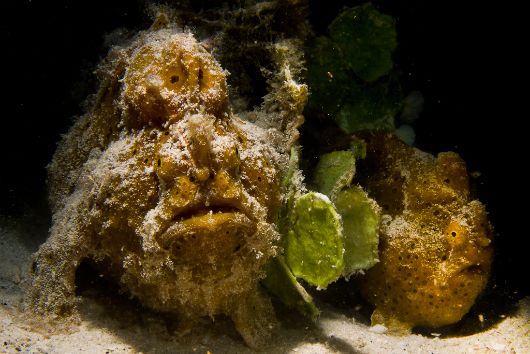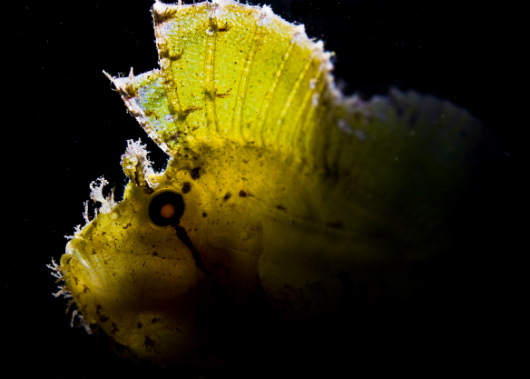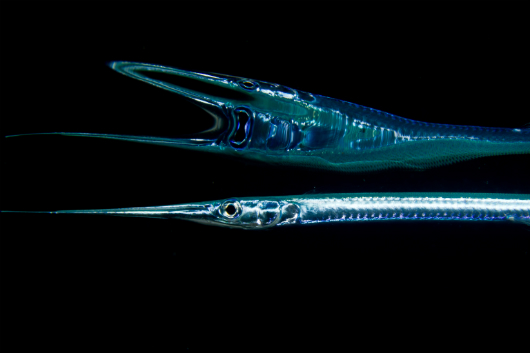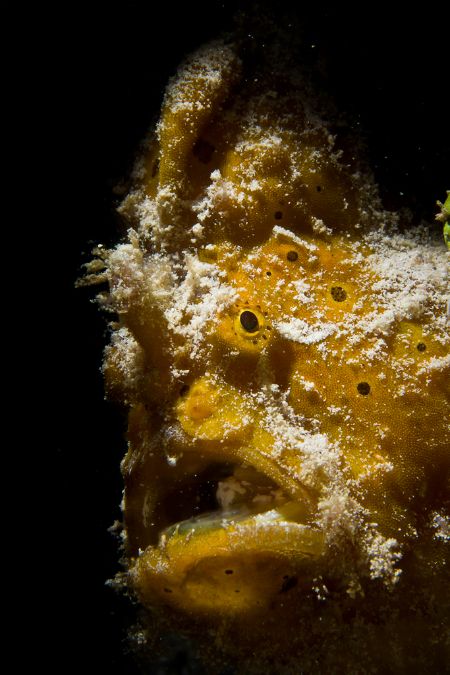Story Behind the Shot: Diving the Shallow Waters of Guam
Story Behind the Shot: The Shallow Waters of Guam
First place winner in the "Novice dSLR" category of our Ocean Art Contest, Tony Cherbas describes how he got his winning shot
by Tony Cherbas

"Narcissus," Tony's winning shot in the "Novice dSLR" catoegry of our Ocean Art Contest
My first place "Novice dSLR" photo, entitled “Narcissus," was taken at Piti Channel, my favorite local night-dive in Guam. It’s a very shallow dive, about 15 feet at it's deepest point, which I find convenient for long, solo photo sessions. Other than being used for an occasional open-water dive training class, Piti Channel sees very little dive traffic on a regular basis. At night there is usually noone around, and this easy-entry shore dive is probably the best muck dive in Guam. I see things in the channel that I don’t see anywhere else here, including but not limited to; leaf fish, frogfish, conger eels, mantis shrimp, flatheads, large pipefish, juvenile snapper and sweetlips, oscillated lionfish, an assortment of shrimps, crabs and even a small eagle ray that shows up quite regularly on high tides.
My winning photo was taken a year ago, shortly after I bought my first dSLR, on my very first dive with two strobes instead of one. Prior to this I had been shooting with a single strobe positioned directly over the housing. The addition of the second strobe (both Inon z240s) really allowed this shot to happen.
Both strobes were positioned on either side of the housing, one directly under the squid as the camera was positioned vertically, to compose in the traditional portrait style. Recognizing the potential for a unique shot, I followed the subject for a long while in about three feet of water, firing away and recomposing, until I decided that the squid had probably taken enough flash abuse. The greenish swirl of the water was due to the reflection of the dead coral substrate covered with algae that was directly below me.
The strobes were set to S-TTL via fiber optics, which is my preferred way of shooting macro due to ease, cost, and versatility. The use of dual strobes allowed for even lighting over the subject so that the reflection was represented clearly and stood out nicely. I have since been back to Piti Channel to take similar reflection photos with only one strobe and found it much harder to achieve full, even light coverage for this particular composition.
The camera settings were: F 18, 1/160th sec, ISO 100. I will note that due to the amount of particulate matter floating in the water, some backscatter was removed via Adobe Lightroom to clean up the presentation (the RAW file was submitted to the judges to show this). The photo was taken with my former Canon T2I in a Sea & Sea housing. I have since sold the T2I due to the inability to manually adjust the flash output, which greatly impedes the flash recycle time when using S-TTL. This was really the only fault I found with the camera, but a large enough one for my style of shooting that it was necessary for an upgrade. I now shoot with a Nikon D7000 in a Nauticam housing.
I’d like to thank Scott, Michael and everyone at the Underwater Photography Guide for an excellent website that offers a wealth of information for those starting out in the hobby. And of course I’d like to thank the judges for selecting my photo for first place in the "Novice" category and awarding me with an unbelievable prize package to Papua New Guinea!
Other Photos from the Shoot

Canon 60mm, F/20, 1/200, ISO 200. Piti Channel, Guam

Nikkor 40mm, F10, 1/200, ISO 250. Lit with fiber optic snoot, Piti Channel, Guam

Canon 60mm, F/18, 1/200, ISO 200. Piti Channel, Guam

Canon 60mm, F18, 1/200, ISO 200. Lit with Seahorn Snoot Piti Channel, Guam
Further Reading
Support the Underwater Photography Guide
Please support the Underwater Photography Guide by purchasing your underwater photography gear through our sister site, Bluewater Photo and Video. Click, or call them at (310) 633-5052 for expert advice!
RECOMMENDED ARTICLES
SUPPORT THE UNDERWATER PHOTOGRAPHY GUIDE:
The Best Service & Prices on u/w Photo Gear
 Visit Bluewater Photo & Video for all your underwater photography and video gear. Click, or call the team at (310) 633-5052 for expert advice!
Visit Bluewater Photo & Video for all your underwater photography and video gear. Click, or call the team at (310) 633-5052 for expert advice!
The Best Pricing, Service & Expert Advice to Book your Dive Trips
 Bluewater Travel is your full-service scuba travel agency. Let our expert advisers plan and book your next dive vacation. Run by divers, for divers.
Bluewater Travel is your full-service scuba travel agency. Let our expert advisers plan and book your next dive vacation. Run by divers, for divers.
































